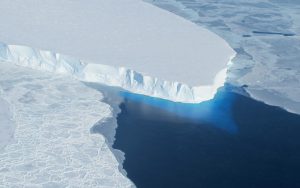Rugged peaks, deep lakes and flat terrain: a research expedition has mapped for the first time the terrain beneath Antarctica's Thwaites Glacier, Earth's largest glacier. Mapping reveals a varied terrain with areas of breaking and sliding beneath the 800- to 1,200-meter-thick ice sheet. 100 ocean deep lakes are found beneath the Great Ice Stream. Knowledge of this subglacial landscape now enables us to more accurately assess the future of Thwaites Glacier.
The Thwaites Glacier in West Antarctica is one of the largest ice streams in the region and the widest glacier on Earth: in front of it, flowing into the Amundsen Sea, it is 120 kilometers wide. The influence of the massive ice flow is correspondingly large: ice loss from this one glacier is already responsible for four percent of global sea-level rise. Thwaites Glacier's tongue has been eroded by warm deep water and is riddled with crevasses.
If the Thwaites Glacier melts completely, the global sea level will rise by 65 centimeters. It is therefore important to estimate the further growth of this ice giant as accurately as possible.

By vibrating plates and radar
That is why the research team of the “International Thwaites Glacier Collaboration” (ITGC) has been intensively researching the Thwaites Glacier site for the past two years. A major focus was on mapping the glacier bed – the terrain beneath the ice flow. Their shape and the properties of the Antarctic Thwaites glacier base influence how quickly the glacier will retreat and contribute to sea level rise.
During two field trips, snowcats and airplanes took researchers from the British and American polar stations Rothera and McMurdo to Thwaites Glacier, 1,600 kilometers away. At the site, the team used special vibration plates to study earthquakes. 480 geophones recorded waves reflected from the ice and the underlying ice. In addition, the researchers mapped the surface of the sub-glacier using high-resolution radar measurements.
Rugged rocks and smooth plains
The result was the first accurate map of the terrain beneath Thwaites Glacier. For the first time, this ice provides insights into what the stream's surface looks like. “Knowing the characteristics of the Thwaites Glacier flow bed is not the most important information to improve predictions of how quickly it will lose ice in the future,” explains Robert Larder of the British Antarctic Survey. “New results begin to close this gap.”
In particular, the mapping revealed a varied sub-glacial landscape: relatively flat areas of a few kilometers long characterized by soft, smooth sediments. Such sub-glacial plains make it easier for glaciers to slide underground and therefore create “slides” for ice flow. However, in between there are always regions with rugged terrains characterized by rugged terrain in which mountains and cliffs rise to hundreds of meters in height. These act as a brake on the flow of snow.
Also surprising: Under parts of Thwaites Glacier, the team discovered sub-glacial lakes 100 meters deep.
Evidence for glacial dynamics
“This is the first time a clear picture of such a large landscape has been obtained,” said Olaf Eisen of the Alfred Wegener Institute. .”
The new measurements show that the glacier floor in the area still covered by ice is similar to the area in front of the glacier tongue that has already melted. “New seismic data collected offshore confirm strong similarities,” Larder says. This will allow conclusions to be drawn about the glacier's future movement and vulnerability.
Sometimes soft, sometimes hard
The seismic images also revealed striking structures within the glacial ice. These so-called englacial reflections are seen primarily in Thwaites Ice Stream areas, where the surface is rough. This suggests that the ice above these rough areas of rock is further deforming and the ice crystals there are aligning with the prevailing stresses. This means that the glacial ice is smoother in one direction than the other. Future ice flow models should take this into account. (European Geosciences Union (EGU) Meeting 2024)
Source: Alfred Wegener Institute, Helmholtz Center for Polar and Marine Research (AWI), British Antarctic Survey (BAS)
April 19, 2024 – Nadja Podbregar